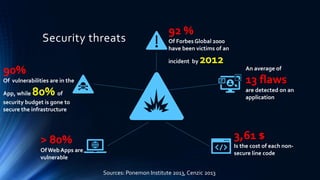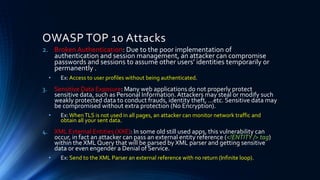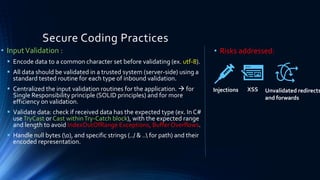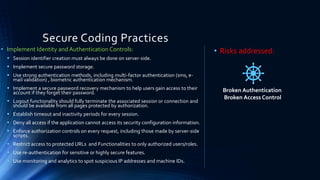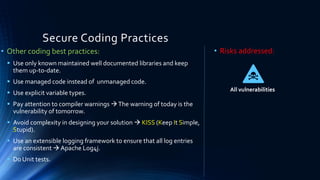Secure coding guidelines
- 1. Secure Coding Guidelines HACK IN THE LOCK HACKATHON – JULY 2020
- 2. About me • user@server:/home/user:$ whoami > Zakaria SMAHI • user@server:/home/user:$ uname -a > Zakaria SMAHI Software Engineer <linkedin.com/in/zsmahi> • user@server:/home/user:$ history | grep ‘experience’ | more > ▪ Software Engineer and Information System Security Enthusiast. ▪ +6 years experience in software development & software design ▪ Talks and workshops in different IT events slideshare.net/zsmahi
- 3. Summary • State of Software Market • How &When do Cyber Attacks occur ? • CommonWeb Attacks - OWASPTop 10. • Secure coding Lifestyle.
- 4. State of Software Market HOW SOFTWARE MARKET HAS EVOLVED
- 5. Market Revolution Industrial Software Client-Server Apps Web Apps Mobile Apps IoT 1 Billion web sites all around the globe by Feb. 2014 102 Billions downloaded mobile app by 2013 212 Billions Connected devices by 2020 Sources: NetCraft 2014, Gartner
- 6. Security threats 92 % Of Forbes Global 2000 have been victims of an incident by 2012 An average of 13 flaws are detected on an application 3,61 $ Is the cost of each non- secure line code > 80% Of Web Apps are vulnerable 90% Of vulnerabilities are in the App, while 80% of security budget is gone to secure the infrastructure Sources: Ponemon Institute 2013, Cenzic 2013
- 7. How & When do Cyber Attacks occur ? HOW SOFTWARE MARKET HAS EVOLVED
- 8. How do Cyber attacks occur ? • In order to answer this question we should understand first the Software Development Life-Cycle and Attacks Life-Cycle concepts. • Software Development Life-Cycle (SDLC) (aka Application Development Life-Cycle) is the process for planning, creating, testing and deploying an Information System. • Attacks Life-Cycle (ALC) is the process by which sophisticated attacks are conducted.
- 9. Software Development Life-Cycle – SDLC 1 PLANNING 2 ANALYSIS 3 DESIGN 4 IMPLEMEN TATION 5TESTING & INTEGRATI ON 6 MAINTENA NCE Each new feature passes through this cycle 1. Planning 2. Analysis & Design 3. Implementation 4. Testing 5. Deployment 6. Maintenance → GoTo 1 a) Fixing Bugs b) Developing extra-feature Source:Wikipedia
- 10. Attacks Life-Cycle – ALC 1 Reconnaissance 2 Initial Compromise 3 Command & Control 4 Lateral Movement 5Target attainment 6 Exfiltration, Corruption & Disruption The typical steps involved in a breach are 1. Reconnaissance – InformationGathering 2. Initial compromise: Bypassing perimeter defenses & gaining access to the internal system 3. Command & Control: downloading & installing a trojan. 4. Lateral Movement: seeking to compromise additional accounts 5. Target attainment: the attacker has multiple remote entry points and he understands the IT environment. 6. Exfiltration,Corruption & Disruption: Enjoy “the coffin dance music“! Source: HelpNetSecurity
- 11. How do Cyber attacks occur ? • After understanding each Life-cycle, we can say that a vulnerability can appear because of some problems at one (or more) stage(s) of software life- cycle: ▪ Planning and Analysis : lack of understanding of the need. ▪ Design: no or bad architecture. ▪ Development: No error catching, No user inputs validation, using vulnerable libraries. ▪ Testing : no tests or not enough tests. ▪ Maintenance: creating new bugs when trying to fix old ones. • In this presentation we’ll focus essentially on development phase and how to apply secure coding principles. • Since > 90 % of attacks are on the web and it’s the era of Cloud we’ll focus our study on web vulnerabilities & web development, but it’s still applicable on desktop apps.
- 12. Common Web Attacks OWASP TOP 10
- 13. OWASP TOP 10 • The OWASPTop 10 is a standard awareness document for developers and web application security. • Using this document is the most effective first step to democratize the secure software development security within your organization. • It represents a broad consensus about theTOP 10 most critical security risks to web applications. • Globally recognized by developers as the first step towards more secure coding.
- 14. 1. Injection: (SQL Injections, NoSQL Injections, LDAP injections & OS Command Injections):This type of attacks occur when user inputs are not validated before being sent to an interpreter, which conducts to its execution as a part of a command or a query, the impact will be the gathering of sensitive data (ex. User accounts, ServerVersions,…etc.). • Ex SQL Injection:The query executed for checking a user is: • SELECT * FROM UsersWhere username = ‘{UserInput}’ • Possible SQL Injection strings : • SELECT * FROM Users Where username = ‘’OR ‘1’=‘1’ →The attacker can obtain all users. • SELECT * FROM Users Where username = ‘zsmahi’; DELETE FROM Users Where username = ‘admin’ OWASP TOP 10 Attacks
- 15. • Ex OS Command Injection:This code call the cat command to show the content of a file. • It’s executed like this : $ ./CommandCat file.txt • The output will be : “this is the content of file.txt” • But what happen if I pass this parameter : file.txt; ls • The interpreted command will be cat file.txt; ls • The output will be: • “this is the content of file.txt” • File.txt; anotherFile.txt; OWASP TOP 10 Attacks
- 16. 2. Broken Authentication: Due to the poor implementation of authentication and session management, an attacker can compromise passwords and sessions to assume other users’ identities temporarily or permanently . • Ex: Access to user profiles without being authenticated. 3. Sensitive Data Exposure: Many web applications do not properly protect sensitive data, such as Personal Information.Attackers may steal or modify such weakly protected data to conduct frauds, identity theft, …etc. Sensitive data may be compromised without extra protection (No Encryption). • Ex:WhenTLS is not used in all pages, an attacker can monitor network traffic and obtain all your sent data. 4. XML External Entities (XXE): In some old still used apps, this vulnerability can occur, in fact an attacker can pass an external entity reference (<!ENTITY /> tag) within the XML Query that will be parsed by XML parser and getting sensitive data or even engender a Denial of Service. • Ex: Send to the XML Parser an external reference with no return (Infinite loop). OWASP TOP 10 Attacks
- 17. OWASP TOP 10 Attacks 5. Broken Access Control : Even with a good session management, an attacker can access unauthorized functionalities or data and perform non permitted operations normally for a simple user. • Ex: Access to admin panel with a normal user credentials.. 6. Security Misconfiguration : Even if security misconfiguration is not seen, but it can help an Attacker in his crime by giving him information about the server, deployed frameworks (Information Gathering). • Ex: Non secure Http Headers, enabled debug mode in production,Verbose Error Messages & Exceptions. 7. Cross Site Scripting (XSS): It occurs whenever an application sends data to web client without proper validation or escaping (Not encoded). XSS allows hacker to execute scripts in victim’s browser to redirect him to malicious web site or hijacking his session. It can be reflected or stored. • Ex: the Script tag: <script>alert(Document.cookies)</script> to steal users' cookies.
- 18. OWASP TOP 10 Attacks 8. Insecure Deserialization : Called also Untrusted Deserialization, when an input can be modified by user, the result will be an untrusted deserialization vulnerability, in fact the deserialized string can contain a remote malicious code that will be executed when converted back to binary format • Ex: CVE-2017-9805Vulnerability discovered in Apache Struts Framework. 9. Using Components with known vulnerabilities: Frameworks, libraries and any software module run with the same privileges as the caller app, so when we use a vulnerable component, we may undermine application defenses and enable various attacks and impacts. • Ex: Bootstrap 3.4.1 contains an XSS vulnerability <CVE-2019-8331>. • Ex: SAP NetWeaverAS JAVA (LM ConfigurationWizard) 7.30 contains a broken authentication <CVE-2020-6287>. 10. Insufficient Logging & Monitoring: Even if it’s not a real attack but without a good logging strategy and without monitoring, attackers can maintain persistence and pivot to more systems. Most breach studies show time to detect a breach is over 200 days, typically detected by external parties rather than internal processes or monitoring.
- 19. 0 0,5 1 1,5 2 2,5 3 Exploitability Prevelance DetectabilityTechnical Impact Business Impact **** Comparison between Attacks Injection XSS XXE BAC * ILM ** CKV *** - *BAC : Broken Access Control - ** ILM :Insufficient Logging & Monitoring - *** CKV : using Component with KnownVulnerabilities - ****The business Impact depends on the organization, its size and its data
- 20. Secure Coding Lifestyle /* LIFE RUNS BETTER ON SECURE CODE */
- 21. Secure Coding Lifestyle • Now, after understanding common vulnerabilities and their impact, it’s high time to change our bad habits and to adopt a new coding lifestyle. • In a world where attacks are inevitable, secure coding becomes a requirement. • So what should I do to make my code more secure?
- 22. Secure Coding Practices • InputValidation : ▪ Encode data to a common character set before validating (ex. utf-8). ▪ All data should be validated in a trusted system (server-side) using a standard tested routine for each type of inbound validation. ▪ Centralized the input validation routines for the application. → for Single Responsibility principle (SOLID principles) and for more efficiency on validation. ▪ Validate data: check if received data has the expected type (ex. In C# useTryCast or Cast withinTry-Catch block), with the expected range and length to avoid IndexOutOfRange Exceptions, Buffer Overflows. ▪ Handle null bytes (0), and specific strings (../ & .. for path) and their encoded representation. • Risks addressed: Injections XSS Unvalidated redirects and forwards
- 23. Secure Coding Practices • Output Encoding : ▪ All data should be encoded in a trusted system (server-side) using a standard tested routine for each type of inbound validation. ▪ Modern backend programming languages include different encoding types (html, css, javascript, url). ▪ Centralized the output encoding routines for the application. ▪ Validate data: Prepare response data before sending them. (check if it’s really what’s expected → safe serialization). ▪ Handle null bytes (0). • Risks addressed: Injections XSS Client-Side Injection
- 24. Secure Coding Practices • Parametrize Queries: ▪ Parameterize the queries by binding the variables. ▪ $stmt = $conn->prepare("INSERT INTO MyGuests (firstname, lastname, email)VALUES (?, ?, ?)"); // php code $stmt->bind_param("sss", $firstname, $lastname, $email); ▪ In general way for more security in database : ▪ The application should use the lowest possible level of privilege when accessing the database. ▪ Connection strings should not be hard coded within the application but stored in a separate configuration file on a trusted system and they should be encrypted. • Risks addressed: SQL Injections
- 25. Secure Coding Practices • Implement Identity and Authentication Controls: ▪ Session identifier creation must always be done on server-side. ▪ Implement secure password storage. ▪ Use strong authentication methods, including multi-factor authentication (sms, e- mail validation) , biometric authentication mechanism. ▪ Implement a secure password recovery mechanism to help users gain access to their account if they forget their password. ▪ Logout functionality should fully terminate the associated session or connection and should be available from all pages protected by authorization. ▪ Establish timeout and inactivity periods for every session. ▪ Deny all access if the application cannot access its security configuration information. ▪ Enforce authorization controls on every request, including those made by server-side scripts. ▪ Restrict access to protected URLs and Functionalities to only authorized users/roles. ▪ Use re-authentication for sensitive or highly secure features. ▪ Use monitoring and analytics to spot suspicious IP addresses and machine IDs. • Risks addressed: Broken Authentication Broken Access Control
- 26. Secure Coding Practices • Protect Data & Information: ▪ Use transport layer security (TLS) to encrypt data in transit. ▪ Don’t reinvent the wheel, most programming languages have their own implemented crypto-libraries, so use them wisely. ▪ Return only minimum needed data. → Queries like ‘Select *’ should be avoided as possible. ▪ UseTry-Catch blocks and never return a technical exception. ▪ A well codedTry-Catch block can avoid a DoS. ▪ Technical exception should be logged and return a Business Exception to users ▪ Never return NullReferenceException but return SearchedUserNotFoundException. • Risks addressed: Sensitive Data Exposure Security Misconfiguration
- 27. Secure Coding Practices • Other coding best practices: ▪ Use only known maintained well documented libraries and keep them up-to-date. ▪ Use managed code instead of unmanaged code. ▪ Use explicit variable types. ▪ Pay attention to compiler warnings →The warning of today is the vulnerability of tomorrow. ▪ Avoid complexity in designing your solution → KISS (Keep It Simple, Stupid). ▪ Use an extensible logging framework to ensure that all log entries are consistent → Apache Log4j. ▪ Do Unit tests. • Risks addressed: All vulnerabilities
- 28. Secure Coding Practices • Other coding best practices: ▪ Use proper http code error in your API (200 when OK, 401 when unauthorized, 403 when forbidden,..etc.). ▪ Use secure captcha (ex.Google recaptcha) in forms. ▪ Integrate Security testing in your CI:You can use OWASP ZAProxy, SonarQube (via its security rules), Nexus LifeCycle. ▪ Never trust user inputs, always validate inputs and encode outputs. ▪ Always code as if the person who ends up maintaining your code is a violent psychopath who knows where you live. ▪ Never stop learning, because once you stop learning you start dying. • Risks addressed: All vulnerabilities
- 29. QUESTIONS ?
- 30. Further reading • OWASPTOP 10: https://owasp.org/www-project-top-ten/ • OWASP Secure Coding Practices: https://owasp.org/www-pdf- archive/OWASP_SCP_Quick_Reference_Guide_v2.pdf • ANSSI Recommandations : https://www.ssi.gouv.fr/ • 9hours free online training to understand secure coding principles: https://www.cybrary.it/course/secure-coding/
- 31. THANKS FOR YOUR ATTENTION !






